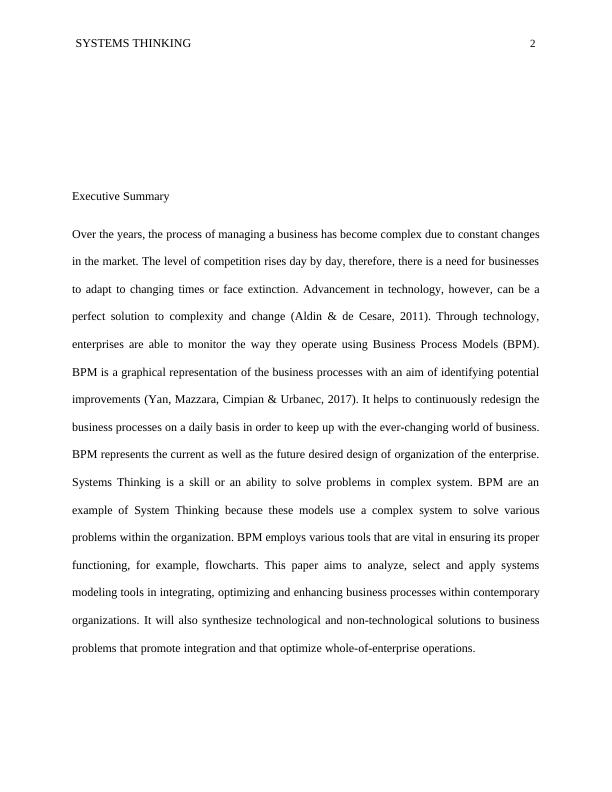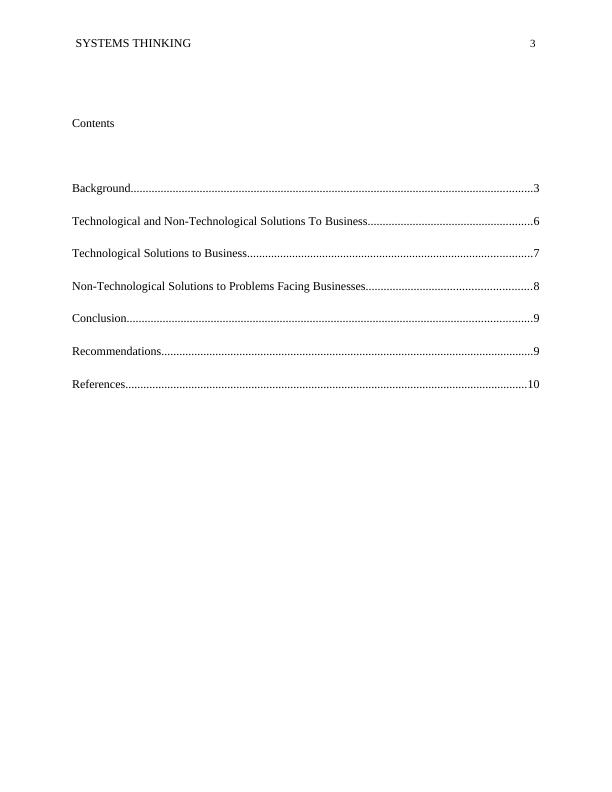Systems Thinking: Integrating, Optimizing and Enhancing Business Processes
Added on 2022-10-01
13 Pages3100 Words424 Views
Running Head: SYSTEMS THINKING
1
SYSTEMS THINKING
Student’s Name
Professor’s Name
Course
Date
1
SYSTEMS THINKING
Student’s Name
Professor’s Name
Course
Date

SYSTEMS THINKING 2
Executive Summary
Over the years, the process of managing a business has become complex due to constant changes
in the market. The level of competition rises day by day, therefore, there is a need for businesses
to adapt to changing times or face extinction. Advancement in technology, however, can be a
perfect solution to complexity and change (Aldin & de Cesare, 2011). Through technology,
enterprises are able to monitor the way they operate using Business Process Models (BPM).
BPM is a graphical representation of the business processes with an aim of identifying potential
improvements (Yan, Mazzara, Cimpian & Urbanec, 2017). It helps to continuously redesign the
business processes on a daily basis in order to keep up with the ever-changing world of business.
BPM represents the current as well as the future desired design of organization of the enterprise.
Systems Thinking is a skill or an ability to solve problems in complex system. BPM are an
example of System Thinking because these models use a complex system to solve various
problems within the organization. BPM employs various tools that are vital in ensuring its proper
functioning, for example, flowcharts. This paper aims to analyze, select and apply systems
modeling tools in integrating, optimizing and enhancing business processes within contemporary
organizations. It will also synthesize technological and non-technological solutions to business
problems that promote integration and that optimize whole-of-enterprise operations.
Executive Summary
Over the years, the process of managing a business has become complex due to constant changes
in the market. The level of competition rises day by day, therefore, there is a need for businesses
to adapt to changing times or face extinction. Advancement in technology, however, can be a
perfect solution to complexity and change (Aldin & de Cesare, 2011). Through technology,
enterprises are able to monitor the way they operate using Business Process Models (BPM).
BPM is a graphical representation of the business processes with an aim of identifying potential
improvements (Yan, Mazzara, Cimpian & Urbanec, 2017). It helps to continuously redesign the
business processes on a daily basis in order to keep up with the ever-changing world of business.
BPM represents the current as well as the future desired design of organization of the enterprise.
Systems Thinking is a skill or an ability to solve problems in complex system. BPM are an
example of System Thinking because these models use a complex system to solve various
problems within the organization. BPM employs various tools that are vital in ensuring its proper
functioning, for example, flowcharts. This paper aims to analyze, select and apply systems
modeling tools in integrating, optimizing and enhancing business processes within contemporary
organizations. It will also synthesize technological and non-technological solutions to business
problems that promote integration and that optimize whole-of-enterprise operations.

SYSTEMS THINKING 3
Contents
Background......................................................................................................................................3
Technological and Non-Technological Solutions To Business.......................................................6
Technological Solutions to Business...............................................................................................7
Non-Technological Solutions to Problems Facing Businesses.......................................................8
Conclusion.......................................................................................................................................9
Recommendations............................................................................................................................9
References......................................................................................................................................10
Contents
Background......................................................................................................................................3
Technological and Non-Technological Solutions To Business.......................................................6
Technological Solutions to Business...............................................................................................7
Non-Technological Solutions to Problems Facing Businesses.......................................................8
Conclusion.......................................................................................................................................9
Recommendations............................................................................................................................9
References......................................................................................................................................10

SYSTEMS THINKING 4
Background
Systems modeling tools are comprised in the Business Process Models (BPM).
Business Process Modeling is a graphical representation of the enterprise which aims to
recognize limitations and to make improvements in order to cope up with the complex and
changing world of business (Jasiulewicz-Kaczmarek, Waszkowski, Piechowski &
Wyczółkowski, 2017). Examples of BPM notations are Business Process Modeling Notation
(BPMN), Unified Modeling Language (UML), Business Process Execution Language for Web
Services (BPEL4WS), Web Service Description Language (WSDL), Event-driven Process
Chains (EPC) and XML Process Definition Language (XPDL). Of the above, the most
commonly used notation is the Business Process Modeling Notation (BPMN). It offers
geographical representation of specific aspects of the business (Keramati, Golian & Afshari-
Mofrad, 2011). Most BPM tools support BPMN as opposed to the other notations.
There are hundreds of Business Process Modeling tools and can be thus classified
according to their functions. The main reason for this is that they are specifically designed to
perform different tasks and are based on different technology all together. One such
classification based on workflow (Aagesen, & Krogstie, 2017). These tools ate tasked with
ensuring that the enterprise understands the current and future organization. They answer the
question of what and why the enterprise is doing. These tools include flowcharts and maps. The
tools are able to highlight the enterprise objectives and identify any form of errors. They improve
the overall performance of the enterprise.
The next classification is Activity –based costing. These mostly deal with
accounting within the business. The activity-based costing (ABC) tools determine the total value
of the enterprise and can detect any form of miscalculations and correct it. The main objective of
Background
Systems modeling tools are comprised in the Business Process Models (BPM).
Business Process Modeling is a graphical representation of the enterprise which aims to
recognize limitations and to make improvements in order to cope up with the complex and
changing world of business (Jasiulewicz-Kaczmarek, Waszkowski, Piechowski &
Wyczółkowski, 2017). Examples of BPM notations are Business Process Modeling Notation
(BPMN), Unified Modeling Language (UML), Business Process Execution Language for Web
Services (BPEL4WS), Web Service Description Language (WSDL), Event-driven Process
Chains (EPC) and XML Process Definition Language (XPDL). Of the above, the most
commonly used notation is the Business Process Modeling Notation (BPMN). It offers
geographical representation of specific aspects of the business (Keramati, Golian & Afshari-
Mofrad, 2011). Most BPM tools support BPMN as opposed to the other notations.
There are hundreds of Business Process Modeling tools and can be thus classified
according to their functions. The main reason for this is that they are specifically designed to
perform different tasks and are based on different technology all together. One such
classification based on workflow (Aagesen, & Krogstie, 2017). These tools ate tasked with
ensuring that the enterprise understands the current and future organization. They answer the
question of what and why the enterprise is doing. These tools include flowcharts and maps. The
tools are able to highlight the enterprise objectives and identify any form of errors. They improve
the overall performance of the enterprise.
The next classification is Activity –based costing. These mostly deal with
accounting within the business. The activity-based costing (ABC) tools determine the total value
of the enterprise and can detect any form of miscalculations and correct it. The main objective of

End of preview
Want to access all the pages? Upload your documents or become a member.
Related Documents
Business Process Model and Notification (BPMN)lg...
|5
|683
|27
Business Process Managementlg...
|9
|1844
|379
Benefits and Challenges of Business Process Modellinglg...
|4
|803
|21
Modern Business Process Modelinglg...
|8
|1559
|170
Operations and Information Management - CC Musiclg...
|14
|4056
|55
Report on Design and Implementation of a Databaselg...
|10
|1641
|16
